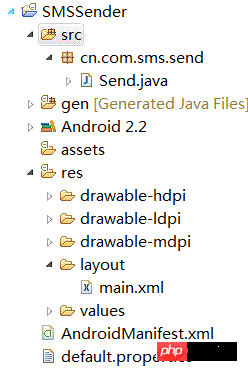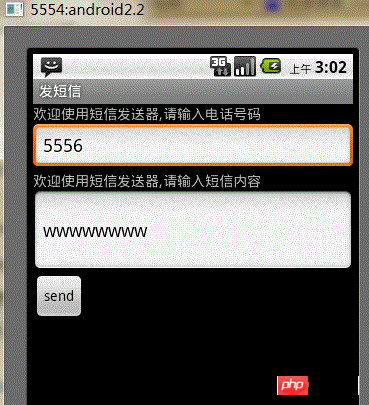 WeChat Applet
WeChat Applet
 Mini Program Development
Mini Program Development
 Android small program sample code for sending text messages
Android small program sample code for sending text messages
Android small program sample code for sending text messages
This article mainly introduces the example of a small program for sending text messages during development in Android. The article also comes with an example of an upgraded version of sending text messages that monitors broadcast receivers. Friends who need it can refer to it

The above picture is the code structure diagram.
Now let’s look at the specific code.
Send.java
package cn.com.sms.send;
import java.util.ArrayList;
import java.util.Iterator;
import android.app.Activity;
import android.app.PendingIntent;
import android.content.Intent;
import android.os.Bundle;
import android.telephony.SmsManager;
import android.util.Log;
import android.view.View;
import android.widget.Button;
import android.widget.EditText;
import android.widget.Toast;
public class Send extends Activity {
private String message;
private String number ;
private EditText editText;
private EditText editText2;
@Override
public void onCreate(Bundle savedInstanceState) {
super.onCreate(savedInstanceState);
setContentView(R.layout.main);
editText = (EditText) this.findViewById(R.id.number);
editText2 = (EditText)this.findViewById(R.id.message);
Button button = (Button)this.findViewById(R.id.button);
button.setOnClickListener(new View.OnClickListener() {
public void onClick(View v) {
number = editText.getText().toString();
message = editText2.getText().toString();
// 在LogCat中可以查看到number和message的相关信息
Log.i("number", number);
Log.i("message", message);
/*获取系统默认的信息管理器,一定要注意的是SmsManager是android.telephony.SmsManager;这和
*我们使用的版本有关,在 Android 2.0 以前 应该使用 android.telephony.gsm.SmsManager
*Android 2.0 之后的版本应该用 android.telephony.SmsManager。
*/
SmsManager smsManager = SmsManager.getDefault();
/*PendingIntent.getBroadcast返回一个用于广播的PendingIntent对象,类似于调用Content.sendBroadcast();
*/
PendingIntent paIntent = PendingIntent.getBroadcast(Send.this, 0, new Intent("SMS_SENT"), 0);
PendingIntent deliveryIntent = PendingIntent.getBroadcast(Send.this, 0, new Intent("SMS_DELIVERED"), 0);
// smsManager.pideMessage有些时候短信如果超过了字数,我们就需要这个方法来帮我们拆分短信内容。
ArrayList<String> smses = smsManager.pideMessage(message);
Iterator<String> iterator = smses.iterator();
while(iterator.hasNext()){
String temp = iterator.next();
//发送短信
smsManager.sendTextMessage(number, null, temp, paIntent, deliveryIntent);
}
// 弹出一个浮动框显示提示内容,Toast.LENGTH_LONG代表浮动框显示时间的长短
Toast.makeText(Send.this, "短信发送完成", Toast.LENGTH_LONG).show();
}
});
}
}
main.xml
<?xml version="1.0" encoding="utf-8"?> <LinearLayout xmlns:android="http://schemas.android.com/apk/res/android" android:orientation="vertical" android:layout_width="fill_parent" android:layout_height="fill_parent" > <TextView android:layout_width="fill_parent" android:layout_height="wrap_content" android:text="欢迎使用短信发送器,请输入电话号码" /> <EditText android:id="@+id/number" android:layout_width="fill_parent" android:layout_height="wrap_content" android:hint="这里输入电话号码" /> <TextView android:layout_width="fill_parent" android:layout_height="wrap_content" android:text="欢迎使用短信发送器,请输入短信内容" /> <EditText android:id="@+id/message" android:layout_width="fill_parent" android:layout_height="wrap_content" android:minLines="3" android:hint="这里输入短信内容" /> <Button android:id="@+id/button" android:layout_width="wrap_content" android:layout_height="wrap_content" android:text="send" /> </LinearLayout>
AndroidManifest.xml
<?xml version="1.0" encoding="utf-8"?>
<manifest xmlns:android="http://schemas.android.com/apk/res/android"
package="cn.com.sms.send"
android:versionCode="1"
android:versionName="1.0">
<uses-sdk android:minSdkVersion="8" />
<uses-permission android:name="android.permission.SEND_SMS"></uses-permission>
<application android:icon="@drawable/icon" android:label="@string/app_name">
<activity android:name=".Send"
android:label="@string/app_name">
<intent-filter>
<action android:name="android.intent.action.MAIN" />
<category android:name="android.intent.category.LAUNCHER" />
</intent-filter>
</activity>
</application>
</manifest>The final rendering is:

Like the phone call applet, two AVDs need to be opened here to perform functional testing.
Thinking:
The main class of text messaging application is SmsManager. Before Android 2.0, you should use android.telephony.gsm.SmsManager
, and later you should use android.telephony.SmsManager;
SmsManager smsManager = SmsManager.getDefault();
, which means to get the system default Information Manager
Series. SCADDDRESS, Text, DELIVERYINTENT) :: target phone number #ACADDRESS: SS: SMS of the service provider The center number (such as China Mobile’s SMS center number) can be left blank for testing.
status
意
-DeliveryIntent: Send-& gt; China Mobile-& gt successful sending; --> Follow-up processing: This intention packages the status information of whether the SMS has been received by the other party (the supplier has sent it successfully, but the other party has not received it).
static
PendingIntent getBroadcast (Context context, int requestCode, Intent intent, int flags)Returns a PendingIntent for broadcast, similar to calling Context.sendBroadcast( )
FunctionrequestCode is not used for the time being
intent is the intent used for broadcastflags include: FLAG_ONE_SHOT, FLAG_NO_CREATE, FLAG_CANCEL_CURRENT
, FLAG_UP
DATE
_CURRENT is used to set the newly created PendingIntent to be used once, if not, do not create, cancel the current, updatecurrent, etc.properties. In addition, we also need to declare the SMS sending permission in AndroidManifest.xml.
Sometimes, when our two AVDs simulate sending text messages, we will find that sometimes the The program cannot be used normally. The system will prompt us NO DNS servers found, and the DNS service cannot be found. This situation is usually caused by your computer not being connected to the network.
Send text message:
##
SmsManager smsMgr = SmsManager.getDefault(); smsMgr.sendTextMessage(address, null, message, null, null);
Show text message writing interface:
Uri smsToUri = Uri.parse("smsto://10086");
Intent mIntent = new Intent( android.content.Intent.ACTION_SENDTO, smsToUri );
startActivity( mIntent );Send email:
Intent i = new Intent(Intent.ACTION_SEND);
i.putExtra(Intent.EXTRA_EMAIL, address);
i.putExtra(Intent.EXTRA_SUBJECT, filename);
i.putExtra(Intent.EXTRA_STREAM, Uri.parse("file://" + filename)); ;
i.setType("text/csv");
startActivity(Intent.createChooser(i, "EMail File"));Upgraded version:
This code adds a broadcast to it Receiver monitoring. The detailed code is as follows
package cn.com.sms.send;
import java.util.ArrayList;
import java.util.Iterator;
import android.app.Activity;
import android.app.PendingIntent;
import android.content.BroadcastReceiver;
import android.content.Context;
import android.content.Intent;
import android.content.IntentFilter;
import android.os.Bundle;
import android.telephony.SmsManager;
import android.util.Log;
import android.view.View;
import android.widget.Button;
import android.widget.EditText;
import android.widget.Toast;
public class Send extends Activity {
private String message;
private String number ;
private EditText editText;
private EditText editText2;
@Override
public void onCreate(Bundle savedInstanceState) {
super.onCreate(savedInstanceState);
setContentView(R.layout.main);
editText = (EditText) this.findViewById(R.id.number);
editText2 = (EditText)this.findViewById(R.id.message);
Button button = (Button)this.findViewById(R.id.button);
button.setOnClickListener(new View.OnClickListener() {
public void onClick(View v) {
number = editText.getText().toString();
message = editText2.getText().toString();
// 在LogCat中可以查看到number和message的相关信息
Log.i("number", number);
Log.i("message", message);
/*获取系统默认的信息管理器,一定要注意的是SmsManager是android.telephony.SmsManager;这和
*我们使用的版本有关,在 Android 2.0 以前 应该使用 android.telephony.gsm.SmsManager
*Android 2.0 之后的版本应该用 android.telephony.SmsManager。
*/
SmsManager smsManager = SmsManager.getDefault();
/*PendingIntent.getBroadcast返回一个用于广播的PendingIntent对象,类似于调用Content.sendBroadcast();
*/
PendingIntent paIntent = PendingIntent.getBroadcast(Send.this, 0, new Intent("SMS_SENT2"), 0);
PendingIntent deliveryIntent = PendingIntent.getBroadcast(Send.this, 0, new Intent("SMS_DELIVERED2"), 0);
// 注册一个BroadcastReceiver,当有匹配它的IntentFilter的Intent出现时,该方法会被触发
registerReceiver(new BroadcastReceiver(){
@Override
public void onReceive(Context context, Intent intent) {
int resultCode = getResultCode();
switch(resultCode){
case Activity.RESULT_OK:
Toast.makeText(getBaseContext(), "信息发送成功了哦、", Toast.LENGTH_LONG).show();
break;
default:
Toast.makeText(getBaseContext(), "信息发送失败了哦、", Toast.LENGTH_LONG).show();
}
}
}, new IntentFilter("SMS_SENT2"));
registerReceiver(new BroadcastReceiver() {
@Override
public void onReceive(Context context, Intent intent) {
Toast.makeText(getBaseContext(), "deliveryIntent", Toast.LENGTH_LONG).show();
Log.i("短信接收人是否查看信息", "看了");
}
}, new IntentFilter("SMS_DELIVERED2"));
// smsManager.pideMessage有些时候短信如果超过了字数,我们就需要这个方法来帮我们拆分短信内容。
ArrayList<String> smses = smsManager.pideMessage(message);
Iterator<String> iterator = smses.iterator();
while(iterator.hasNext()){
String temp = iterator.next();
//发送短信
smsManager.sendTextMessage(number, null, temp, paIntent, deliveryIntent);
}
// 弹出一个浮动框显示提示内容,Toast.LENGTH_LONG代表浮动框显示时间的长短
Toast.makeText(Send.this, "短信发送完成", Toast.LENGTH_LONG).show();
}
});
}
}main.xml and AndroidManifest.xml are the same as the previous code.
registerReceiver() is used to register broadcast receivers. This method is defined in Content.
queries
to find a broadcast that satisfies the filter, it will teach it to the receiver and let it process it. Generally it is handled in its onReceive() method.如果不是在代码中主动通过registerReceiver()进行注册,那么就要从AndroidManifest.xml进行配置,代码如下
<receiver android:name="类名"> <intent-filter> <action android:name="接收者中Intent参数的action属性" /> </intent-filter> </receiver>
这里需要注意,在配置文件中activity标签和receiver标签是平级的。
在模拟器中发送中文会接收方出现乱码的问题,但是在真机中,就不会出现乱码的情况了。所以开发者只需要正常开发短信功能,不需要编码转换。
The above is the detailed content of Android small program sample code for sending text messages. For more information, please follow other related articles on the PHP Chinese website!

Hot AI Tools

Undresser.AI Undress
AI-powered app for creating realistic nude photos

AI Clothes Remover
Online AI tool for removing clothes from photos.

Undress AI Tool
Undress images for free

Clothoff.io
AI clothes remover

Video Face Swap
Swap faces in any video effortlessly with our completely free AI face swap tool!

Hot Article

Hot Tools

Notepad++7.3.1
Easy-to-use and free code editor

SublimeText3 Chinese version
Chinese version, very easy to use

Zend Studio 13.0.1
Powerful PHP integrated development environment

Dreamweaver CS6
Visual web development tools

SublimeText3 Mac version
God-level code editing software (SublimeText3)

Hot Topics
 1386
1386
 52
52
 New report delivers damning assessment of rumoured Samsung Galaxy S25, Galaxy S25 Plus and Galaxy S25 Ultra camera upgrades
Sep 12, 2024 pm 12:23 PM
New report delivers damning assessment of rumoured Samsung Galaxy S25, Galaxy S25 Plus and Galaxy S25 Ultra camera upgrades
Sep 12, 2024 pm 12:23 PM
In recent days, Ice Universe has been steadily revealing details about the Galaxy S25 Ultra, which is widely believed to be Samsung's next flagship smartphone. Among other things, the leaker claimed that Samsung only plans to bring one camera upgrade
 Samsung Galaxy S25 Ultra leaks in first render images with rumoured design changes revealed
Sep 11, 2024 am 06:37 AM
Samsung Galaxy S25 Ultra leaks in first render images with rumoured design changes revealed
Sep 11, 2024 am 06:37 AM
OnLeaks has now partnered with Android Headlines to provide a first look at the Galaxy S25 Ultra, a few days after a failed attempt to generate upwards of $4,000 from his X (formerly Twitter) followers. For context, the render images embedded below h
 IFA 2024 | TCL\'s NXTPAPER 14 won\'t match the Galaxy Tab S10 Ultra in performance, but it nearly matches it in size
Sep 07, 2024 am 06:35 AM
IFA 2024 | TCL\'s NXTPAPER 14 won\'t match the Galaxy Tab S10 Ultra in performance, but it nearly matches it in size
Sep 07, 2024 am 06:35 AM
Alongside announcing two new smartphones, TCL has also announced a new Android tablet called the NXTPAPER 14, and its massive screen size is one of its selling points. The NXTPAPER 14 features version 3.0 of TCL's signature brand of matte LCD panels
 Vivo Y300 Pro packs 6,500 mAh battery in a slim 7.69 mm body
Sep 07, 2024 am 06:39 AM
Vivo Y300 Pro packs 6,500 mAh battery in a slim 7.69 mm body
Sep 07, 2024 am 06:39 AM
The Vivo Y300 Pro just got fully revealed, and it's one of the slimmest mid-range Android phones with a large battery. To be exact, the smartphone is only 7.69 mm thick but features a 6,500 mAh battery. This is the same capacity as the recently launc
 Samsung Galaxy S24 FE billed to launch for less than expected in four colours and two memory options
Sep 12, 2024 pm 09:21 PM
Samsung Galaxy S24 FE billed to launch for less than expected in four colours and two memory options
Sep 12, 2024 pm 09:21 PM
Samsung has not offered any hints yet about when it will update its Fan Edition (FE) smartphone series. As it stands, the Galaxy S23 FE remains the company's most recent edition, having been presented at the start of October 2023. However, plenty of
 New report delivers damning assessment of rumoured Samsung Galaxy S25, Galaxy S25 Plus and Galaxy S25 Ultra camera upgrades
Sep 12, 2024 pm 12:22 PM
New report delivers damning assessment of rumoured Samsung Galaxy S25, Galaxy S25 Plus and Galaxy S25 Ultra camera upgrades
Sep 12, 2024 pm 12:22 PM
In recent days, Ice Universe has been steadily revealing details about the Galaxy S25 Ultra, which is widely believed to be Samsung's next flagship smartphone. Among other things, the leaker claimed that Samsung only plans to bring one camera upgrade
 Xiaomi Redmi Note 14 Pro Plus arrives as first Qualcomm Snapdragon 7s Gen 3 smartphone with Light Hunter 800 camera
Sep 27, 2024 am 06:23 AM
Xiaomi Redmi Note 14 Pro Plus arrives as first Qualcomm Snapdragon 7s Gen 3 smartphone with Light Hunter 800 camera
Sep 27, 2024 am 06:23 AM
The Redmi Note 14 Pro Plus is now official as a direct successor to last year'sRedmi Note 13 Pro Plus(curr. $375 on Amazon). As expected, the Redmi Note 14 Pro Plus heads up the Redmi Note 14 series alongside theRedmi Note 14and Redmi Note 14 Pro. Li
 iQOO Z9 Turbo Plus: Reservations begin for the potentially beefed-up series flagship
Sep 10, 2024 am 06:45 AM
iQOO Z9 Turbo Plus: Reservations begin for the potentially beefed-up series flagship
Sep 10, 2024 am 06:45 AM
OnePlus'sister brand iQOO has a 2023-4 product cycle that might be nearlyover; nevertheless, the brand has declared that it is not done with itsZ9series just yet. Its final, and possibly highest-end,Turbo+variant has just beenannouncedas predicted. T



